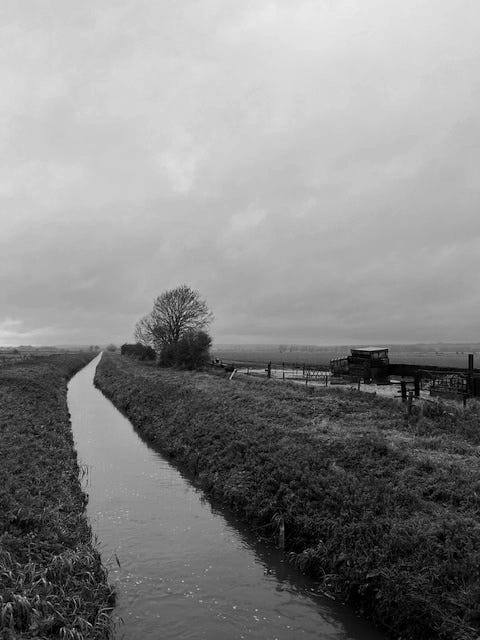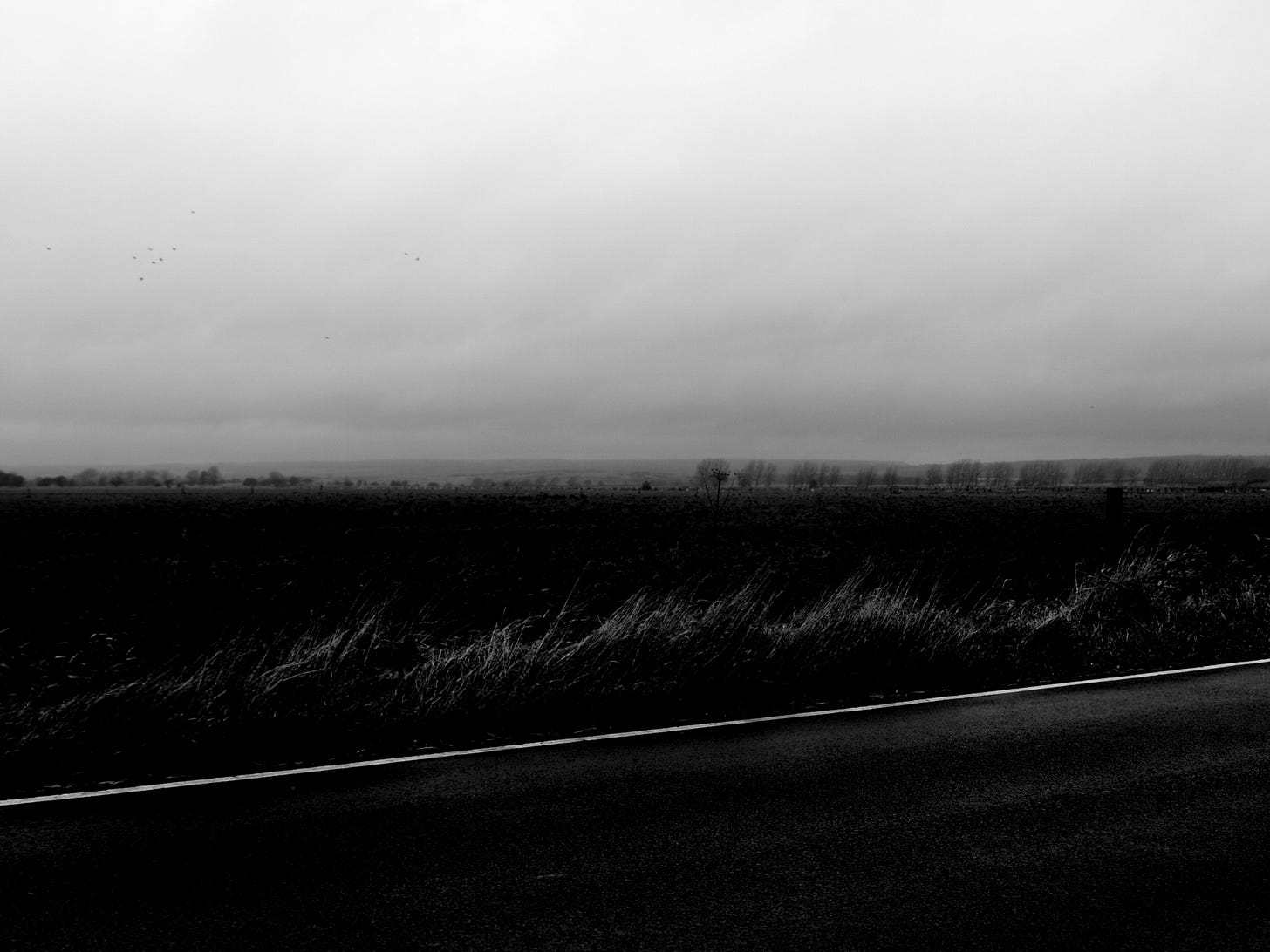Hello friends
Yesterday I tried to take some old wooden rabbit run panels to the tip. It turns out that the tip is closed on Wednesdays, which I knew but thought, inexplicably, that it was already Thursday. I’ve not been well this week, which might explain my confusion. I’ve had a stupid a virus; which has been bad enough to make me uncomfortable and a bit brain-foggy with a cough and a heavy, liquid feeling in my lungs, but not bad enough for me to cancel work. I hate feeling vulnerable. And illness makes me feel exposed, and miserable and like my body is not my own. I have, however, enjoyed my work this week which has mostly been running early morning writing groups. There is something particularly special about the dark morning turning to light as you sit quietly, writing with others. It’s one of my favourite parts of being a facilitator, and of being a writer. I’ve fallen into a pattern of working from 6.30am until about 9am and then going walking with, and sometimes without, the dog. We don’t go so far anymore on account of the dog being quite elderly. But last week I walked up to the river which runs along the edge of our village. The river Hertford is a strange river, it rises just outside another nearby village, Muston, and despite being just a mile from the sea, it flows inland, down the wide, glacier carved valley where I live, where I have always lived. On the day I walked up to it I’d seen a fellow dog walker in the lane. I stroked the long muzzle of his lovely greyhound and we passed the time of day, talking about the ash and the beech leaves and how autumn had arrived so suddenly, how it seemed to do this every year, and that each year we were surprised. His dog waited patiently. My dog wound himself around my legs. He told me he’d been up to the river and had seen a king fisher for the first time in ages. I had never seen one, though had been with people when they had seen one. It seems I have often had my head turned the wrong way when the king fishers appear. On the day we; the dog and I, walked up to the river, we were lucky. We arrived on the wide metal bridge and stood patiently, or rather I stood patiently, but the dog got bored and started winding round my legs and trying to get into the river and then suddenly, out from under the bridge, there was the kingfisher. It was the colour of an Egyptian amulet, jewel-like, the most beautiful, bright blue I have ever seen, completely at odds with the brown, draping, wet landscape. I watched it flit down the length of the river and away and stood with my mouth open in an O of surprise. Perfect.

I visited again, a couple of days later, but the water then was brown with field run off and mud and no kingfisher was seen. I stopped though, as I often do, to look up the length of the river, its straight lines cut into the earth. It is a river that has been redirected, away from its natural course and now I can stand and see down its length as it flies like an arrow across the fields. Sometimes at dawn or dusk it catches the pinks of the sky and carries them with it. In fact my favourite time to come and look at it is at this time, when the world around it is turning to a thick, velvety rural black, and yet it is holding the pink and silver of the sky in its waters.
Once upon a time the river ran its natural course, it curved and writhed through the fenland here, when this land was watery and rich with wildlife. I can still see the dry valleys of its winding course in the fields around my own village. Up until the 19th century it rose regularly in heavy rain, bursting its banks and flooding the fields, feeding the reeds and the water plants as part of the Hertford floodplain. Long ago this place was accessible only by those who knew it well. People would get lost trying to cross it, would drown, would disappear. Long ago this place was known intimately by people living here who fished the waters, gathered the water reed for thatch roofing, caught the wild fowl and maybe eels and definitely fish for food. They probably used boats to cross to the small islands, as the mesolithic people of Star Carr, who lived on the far edge of the lake, probably used boats to do the same thousands of years before them. Only these Yorkshire fen people knew this place well enough not to get lost in it, and could guide travellers across it. Everything changes. Progress is progress, or change is change, but every time I look at the straight course of the river I think about these people whose livelihoods were lost, whose lifestyles were lost.
When land enclosure began in earnest, and the open field system died out and the price of fleece was worth more than the tithe a villager might pay them, the gentry and the wealthy began to find ways of draining the watery land and drying it out for sheep and cattle. The legend is that they used Napoleonic prisoners of war to cut the deep ditches that would alter the course of the Hertford. I have seen no direct evidence of this, but I do believe there were Napoleonic prisoners of war at Scarborough castle when the river was redirected, so it’s possible.
I don’t know if it is me feeling off kilter and vulnerable, but to see the river so straight and angular feels like something bad has happened, as if it has been forced away from its natural self. I like to think of the landscape as a living body, something that needs to be respected and cared for. If the landscape is a body then this river is an example of a body forced to be something it’s not, as if the cut of the river channel is a wound in the landscape. In some places rivers are given the rights of people in order to protect them:
Should rivers have the same rights as people?
It says something about the despair that people feel about their waterways and rivers. Pollution is rife. But people love waterways, I’ve seen it in the outpouring of anger and a kind of grief for the loss of wild swimming that pumping sewage into the sea and the rivers has caused. Around here, in North and Easy Yorkshire, the waterways rivers and streams have been places to build burial mounds and stone circles, the attachment to water as something significant, something spiritual or religious is clear.
In some places rivers are being ‘rewiggled’. They are being allowed to take their natural courses again, for the sake of wildlife, and also to allow flooding to occur on the natural floodplains.
I don’t think this could never happen here, on the Hertford, not at this point anyway. That time is long gone. I can see that the land, which is still springy and boggy in places, would become impassable, and the thing is that nowadays, people are passing over it, crossing the site of the lake, the site of the wetland, living on it in some places. Change happens. It happens naturally, and it happens by force. But it happens.
The river is still beautiful, it still has wildlife: there are otters here, which I have never seen but who have been poaching the fish from my mum’s fishpond for a while, caught on CCTV by a neighbour. There are water voles and migrating birds, and it is still a part of people’s lives. Wounds heal, they become a part of the story of self, and if the landscape is a body, if it is a person with an archive of memories, it has a story to tell.

Dates for your Diary
What can we learn from nature in winter? How can we write about it? Where do we exist in the natural world and how do we tie that world to our own lived experiences, physical and emotional?
Winter is the dark time when the world is waiting: a time for survival, a time for for reflection, a time to experience the darker side of the world and to dig in and recognise the strengths in ourselves and the resilience of the world around us. In this four or six week course (depending on the tier you choose) we’ll be exploring nature in poetry and prose using natural and supernatural themes. From migrant birds arriving and leaving, to insects in their subterranean hideouts, the trees speaking to each other out of sight to the rites and folklore around the darkest days. This is your chance to explore the natural winter world both as an observer and in the context of your place in it. In What to Look for in Winter we’ll explore this world through published works, museum artefacts, film, imagery and physical interaction with nature, using prompts and directed activities to write ourselves into the winter months.
The course starts on 3rd January, a chance for you to start the year by prioritising your writing, perhaps, and to face the post new year’s slump with positivity and courage.
If you are a paid subscriber to Notes from the Margin, you are entitled to a discount on the course, as a thank you for supporting me and my writing.
You can find out more about the course, and book your place on it, here:
The Next Books from the Margin Book Club Book Chat is THIS SUNDAY 12th November 10am UK time. It’s free to paid subscribers. It’s a chance to chat all things books, and you don’t have to have read the book club choice. November’s choice if Jen Campbell’s Please Do Not Touch This Exhibit, which is excellent. I hope to see you there!
Until next time
x








I recently saw a kingfisher in the only way that I only ever tend to see kingfishers, as a bullet of blue firing across the river in front of me. This is a beautiful article. I like to think that all of the harm being done to the nature around us is but a blink of an eye in the long history of the river. That once we're long gone, the river will surge on, not remembering the lumbering primates that saw fit to desecrate it for their own ends.
Thank you for this beautiful piece of writing. I agree with you about humans forcing nature into straightjackets, only to find they're having to deal with flooding in other places. I live near Bishopstoke in Hampshire, where planning permission has been granted to build on the floodplain of the river Itchen. It's only a question of time ... . A few years ago I was lucky to have 2 kingfishers flash past me, quite unexpectedly, in vivid gold and blue. I felt very lucky.